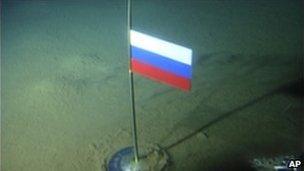Russia to build biggest nuclear-powered icebreaker
- Published

The new ship will be bigger and wider than the current nuclear-powered icebreaker fleet
Russia's plans to build the world's biggest nuclear-powered icebreaker could attract more trade to the country, says a leading UK analyst.
The new ship is meant to be more efficient at breaking ice and able to navigate in deep Arctic waters as well as shallow Siberian rivers.
This could attract more foreign commercial ships, says Matthew Willis of defence think tank Rusi.
Russia is the only country with a nuclear icebreaker fleet.
The state nuclear power corporation, Rosatom, signed a contract for the construction of the new generation icebreaker LK-60 on 23 August.
The vessel will be built at the Baltiysky Zavod shipyard in St Petersburg, and is planned to be completed by the end of 2017.
It will be 173m (568ft) long and 34m (112ft) wide, about 14m longer and 4m wider than the current biggest icebreaker, and will operate on the Northern Sea Route.
Territorial claims
"It is the best channel in the Arctic because the transpolar route and the North West Passage aren't practicable," said Mr Willis from the Royal United Services Institute.

Russia made its ambitions clear by planting a flag beneath the north pole
"Any shipping into the Arctic is probably going to go into the Russian Arctic, so the Russians are trying to make it more attractive to ships.
"It's going from China or Japan to a point in Russia and then out again, carrying natural resources, to delivering them somewhere, and returning for another load."
One-quarter of the world's resources of oil and gas are believed to lie beneath the Arctic Ocean.
Russia, Norway, Canada, Denmark and the United States have already laid claim to territory in the region.
Although the new icebreaker will not have any effect on oil and gas exploration, and is primarily meant for shipping routes, it is another attempt by Moscow to demonstrate its supremacy in the region, says international ecological organisation Bellona.
But the Arctic is not the best place for nuclear ships, it warns.
"The amount of diesel you need to burn to advance through the Arctic ice is enormous, leading to lots of CO2 discharge," Anna Kireeva of Bellona told the BBC.
"So using a nuclear reactor is a big advantage, but there's a risk, because there's nothing in the Arctic to repair a nuclear ship in case of an incident."
- Published22 September 2010
- Published22 September 2010
- Published21 September 2010
- Published16 September 2010